March 31-April 15, 2008
Hello again. It’s been awhile since I’ve written a report. Starting now, reports will be available on a bi-weekly basis. As always there’s been a lot going on. Every day is a new adventure at Planet Drum Ecuador. The biggest recent change has unquestionably been the weather.
By all accounts the rainy season is ending and the long dry season is beginning. There is still an occasional morning drizzle, which will be very important in helping to maintain soil moisture for as late into the coming eight months of dryness as possible. The foliage has also clearly passed its ‘green peak’ with hints of yellow making their presence already. Typical cloudy and cool dry season weather hasn’t set in yet though, the days are still hot and very sunny. But it’s highly unlikely that we will get any of the usual overnight rains so familiar from the wet season. Not coincidentally, we’ve also, as of today in fact, officially wrapped up the planting season with just shy of 1,900 native trees strategically planted on the hillsides lining the eight-kilometer corridor along the south side of the Rio Chone water basin.
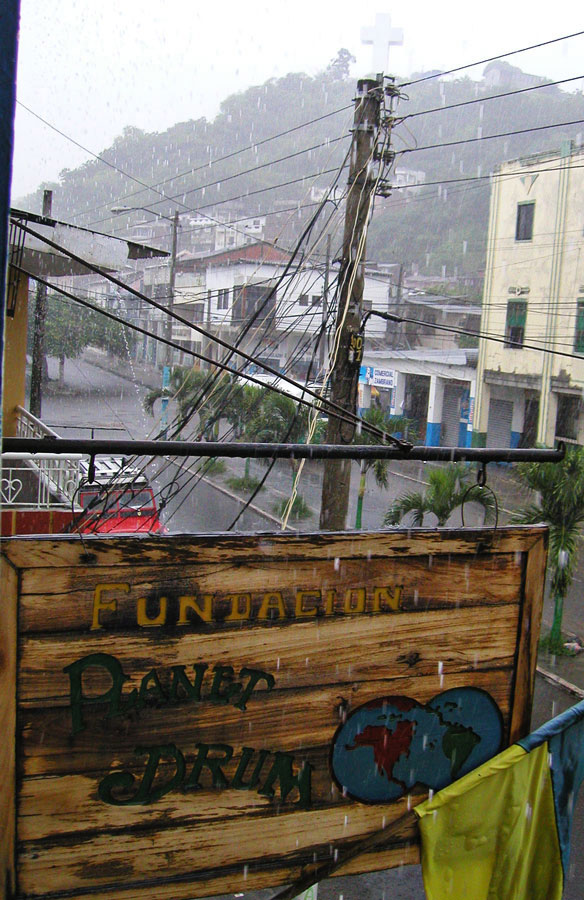
The mass volunteer force, which was here for the bulk of the planting work, dispersed by the end of March. Many, many thanks to all of those involved in what was a monumental revegetation effort. Your blood, especially sweat, and some tears made it possible to plant an unprecedented number of trees this year. Things have subsequently quieted down around the house since, with only a few volunteers around to do maintenance on all of the outdoor sites we planted.
It was great to have Peter Berg, Director and Judy Goldhaft, Managing Director from the Planet Drum San Francisco office visiting for a month. One of the biggest developments during their stay was the restructuring of Jaime, Reforestation Foreman, and my workloads. I’ll be spending less time in the field and greenhouse in the coming months, while Jaime, one of our two Ecuadorian employees (the other is Ramon, Ecuadorian Education-Bioregionalismo Manager) takes over more responsibility of directing and managing volunteers in the field. The main outcome of this change in workloads is that I will have more time to take care of business in the house and around Bahia, including City Hall. I am currently in the process of tackling several major projects in that area: deployment of the Eco-Mandato 2008 (see Dispatch #2), acquiring official NGO status for PDF in Ecuador, and negotiating the legal system to acquire road access to land (south of Bahia) that Planet Drum has purchased for the development of an environmental institute. Side projects include: participating in Eco-amigo negotiations with the Municipio and other Ecuadorian organizations and foundations to help develop Bahia as an eco-city, reestablishing the garbage separation program, and setting up community greenhouses and community reforestation programs.
On the usual revegetation work front, out getting dirty in the hills of Bahia, progress has been very good. We spent approximately three weeks of work simply clearing weeds off of trees planted in January and February. ‘Weeds’ is a bit of an understatement. Vines, other rapidly growing plants, and grasses up to two meters tall grew up to cover the trees and trails we so carefully cleared and planted only a month or so ago.
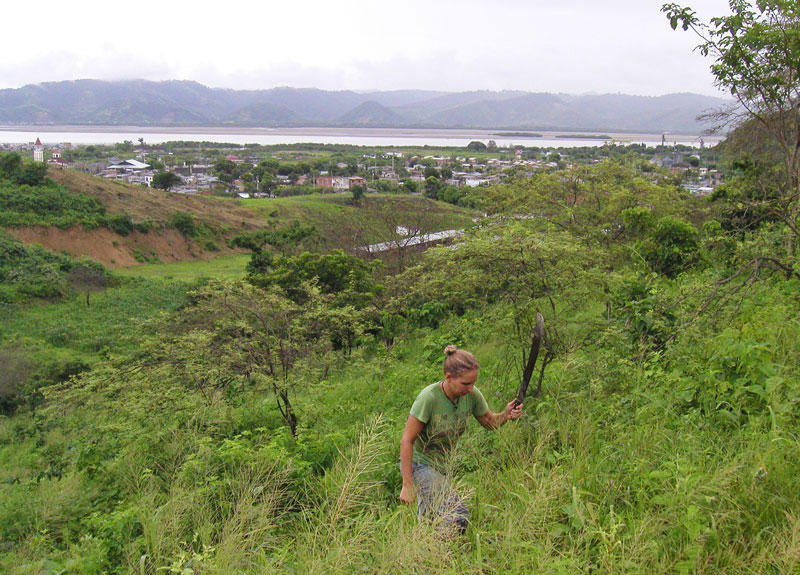
Caroline feels her way through the overgrown mess, locating baby trees along the way.
They needed to be hacked back with precision sharpened machetes in order to be able to clear them as speedily as they were overwhelming us.The same day sun/night rain cycles that persisted throughout the rainy season, which was amazing for the growth of our trees, was also the perfect combination for all of the other plants, many of which aren’t even present during the dry season. Unfortunately they can grow many times faster than the trees. These plants competed for precious rain, sunlight and other sources of nutrients.
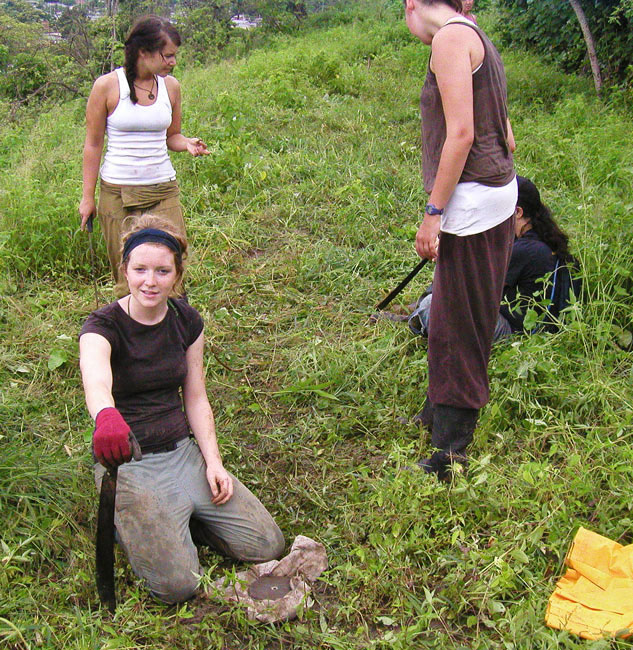
While re-sharpening her machete, Majeeda pauses to catch her breath and reflect on life. (Note sharpening stone by her knee.)
Vines literally pinned planted treesdown to the ground, preventing growth. This problem was particularly acute in sites with little to no previous vegetation shading the land, allowing weeds to grow with nothing holding them back. At ‘La Granja’ site we literally had to walk slowly scrutinizing an entire field which we had planted, looking for trees one by one.
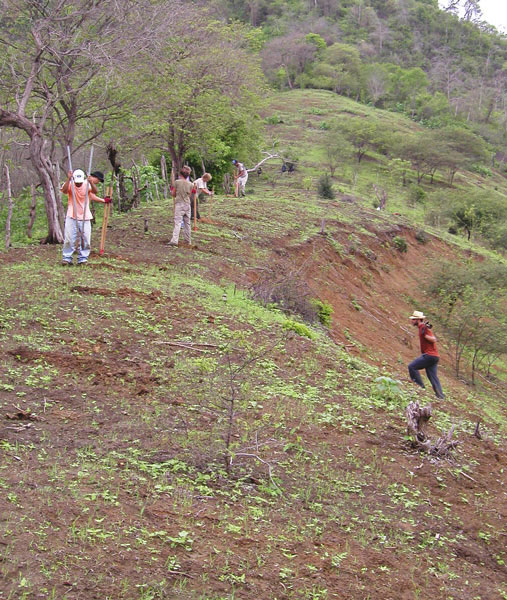
For comparison, the same site,
Learning by doing, as happens here so often, we developed a new system for avoiding this problem in the future. Sticks with red painted tips to identify our trees!
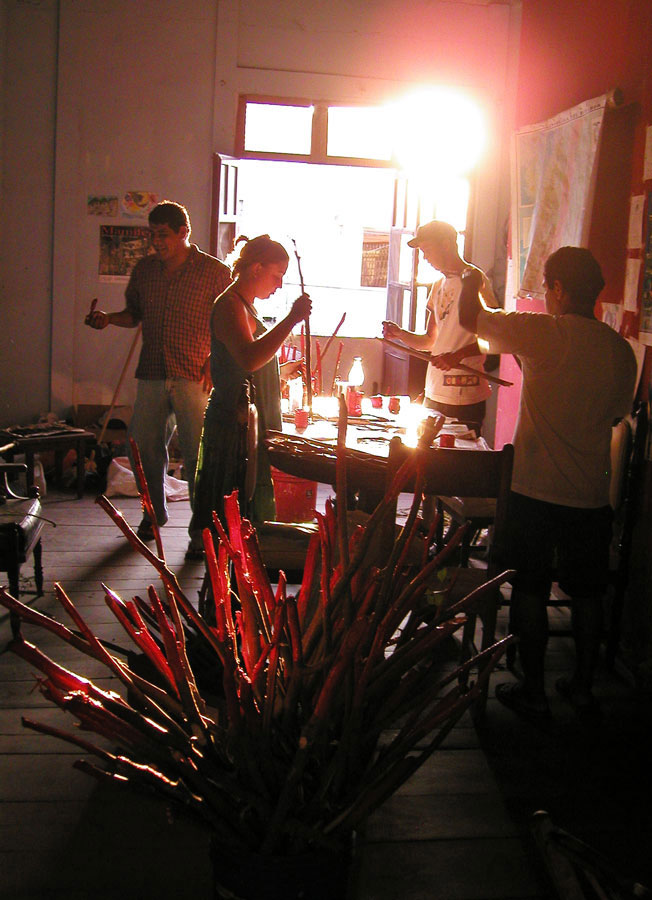
Cheo, Ramon, Jaime and Sara partake in an afternoon stick painting session at the Planet Drum apartment.
Apart from maintaining sites already planted this season, the final four sites happen to be the ‘urban community sites’ for the year: Bosque en Medio de las Ruinas, La Cruz, Reales Tamarindos, and El Astillero. They are in or border local communities. Through community presidents and contacts we attempt to generate as much local involvement as possible in the revegetation process. This includes educating residents about the environment, reforestation and risk of erosion. Most of them are already more than aware of these topics. We need to recruit them to help with planting and watering. Since the sites are literally a part of the community, it is only logical that locals participate in the planting and maintenance of the plants to ensure their survival.
At El Bosque en Medio de las Ruinas we rounded up some local kids to help us squeeze even more trees into the inner-city green park we help maintain. By continuing to work in this area we show the neighborhood that we are serious about keeping the project going; and the more trees the better, though there is definitely limited space in the park for future sites.
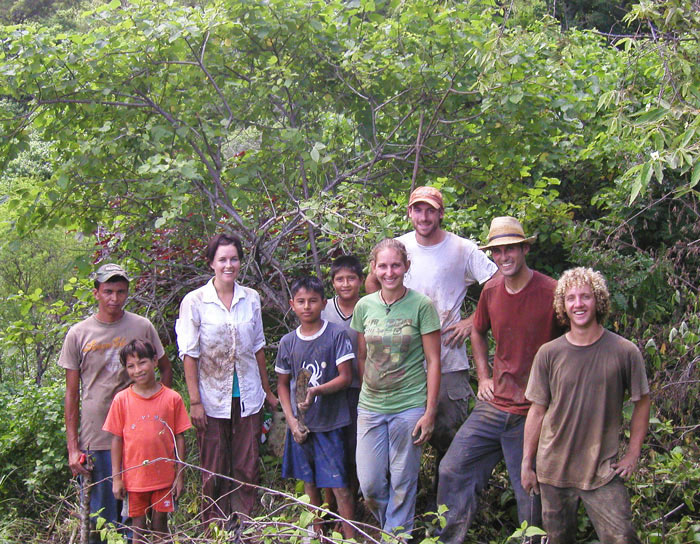
This year’s planting crew for Bosque en Medio de las Ruinas: Planet Drum volunteers and local kids.
This year Lincheros, a native bird, started nesting in a large Ceibo tree on the edge of the park, visible from local resident’s houses.

Planting La Cruz there were even more local hands involved, including some adults. The planting was part of the schedule for Eco-week activities, the annual celebration of Bahia declaring itself an Eco-city in 1999. We scheduled a radio interview for that morning so our efforts were broadcast across the city as we were putting trees in the ground.
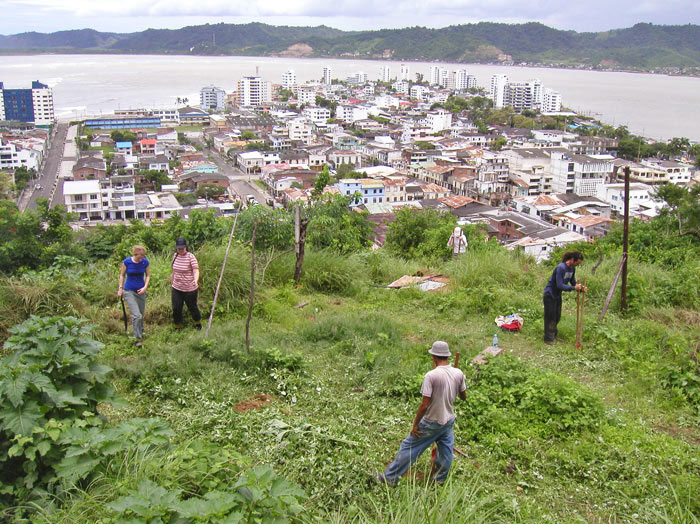
Preparing the La Cruz revegetation site, beloved Bahia and the Rio Chone estuary in the background.
A strong group of community members came to pitch in with the work. Getting nearly a hundred trees planted on the steep hillside of the cross that overlooks the city was almost a breeze.
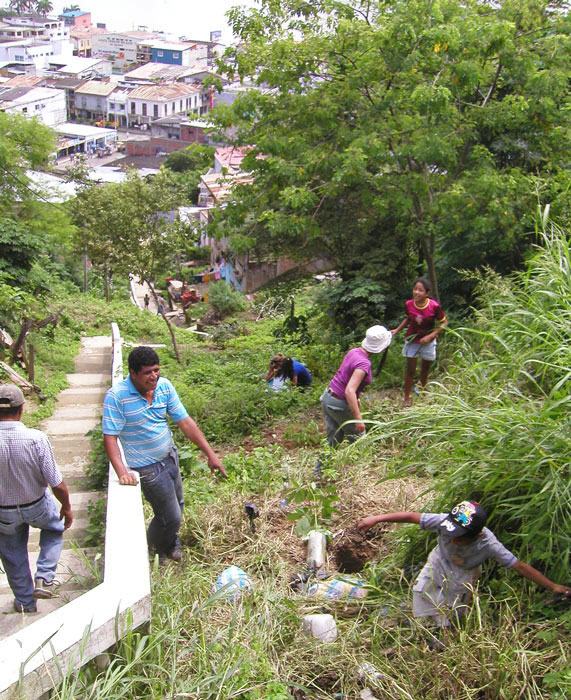
Local kids and adults team up with the Planet Drum crew to plant trees directly above downtown Bahia.
Reales Tamarindos is an exciting site in a brand-new, often overlooked neighborhood between El Astillero and Jorge Lomas. The small community has a good feel and is full of welcoming people. Erosion is beyond severe above it. Despite a high degree of local interest, unfortunately only a small group of kids, a couple of adults, and the community leader came to help us plant. Getting adults to participate on a weekday morning can be a difficult task.Regardless, the community is clearly grateful for the work we are doing, the site increases our exposure in the area, and in a few years the trees will be making an impact on erosion control.
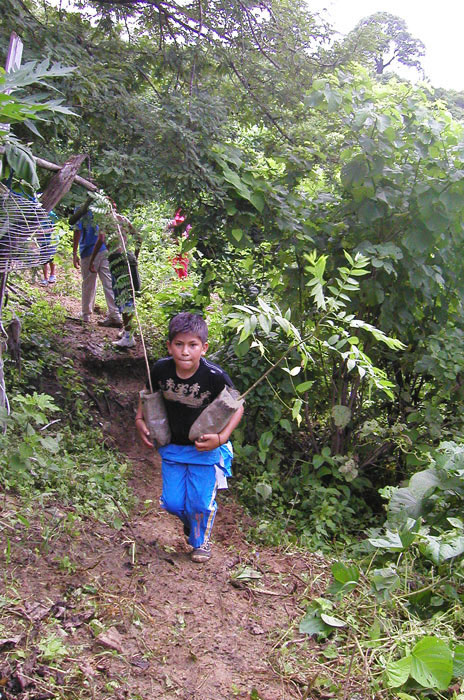
A local kid carries trees up to the site for planting.
Future work can involve getting more people involved and even donating trees directly to members of the community for them to plant, which we began experimenting with this season. A dozen or so trees were given to individuals in Reales Tamarindos for them to plant and maintain.

The view of Leonidas Plaza, a suburb of Bahia from the Reales Tamarindos site. The estuary is visible on the left.
The final site for the year, El Astillero, is new for Planet Drum for a variety of reasons. Previously, El Astillero was left alone by us because of the presence of at least two other vegetation projects in the area, including one to plant non-native grass for erosion control that had a tremendously bloated budget. During our Eco-week open house at the Municipio (City Hall) this past February, four different members from the Astillero community approached our table pleading for a revegetation site in their neighborhood. How could I say no?
El Astillero is one of the most erosion threatened neighborhoods in the region, with already severely eroded hillsides looming over the houses below. But our work there in recent weeks has already exposed problems of community bickering, and the problem of complacency. While eager to complain, people have come to expect outside fixes and financing to solve their problems because of the previous projects there. This exists everywhere to varying degrees, but has definitely been exacerbated in this community.
Regardless, there are a number of opportunities for planting here, the most obvious of which is the enormous hillside that needs to be vegetated to prevent sliding, knocking over houses, and adding silt into the estuary. The community, at least some members, have already been involved in garbage separation to produce compost on their own, despite the local government’s failure to maintain city-wide separation. Some locals are even pushing the city to help them finance a local greenhouse so they can grow their own fruit trees to plant in backyards and open spaces. The community is large enough that it has its own school, with the possibility for school kids to get ongoingly involved in local activities.
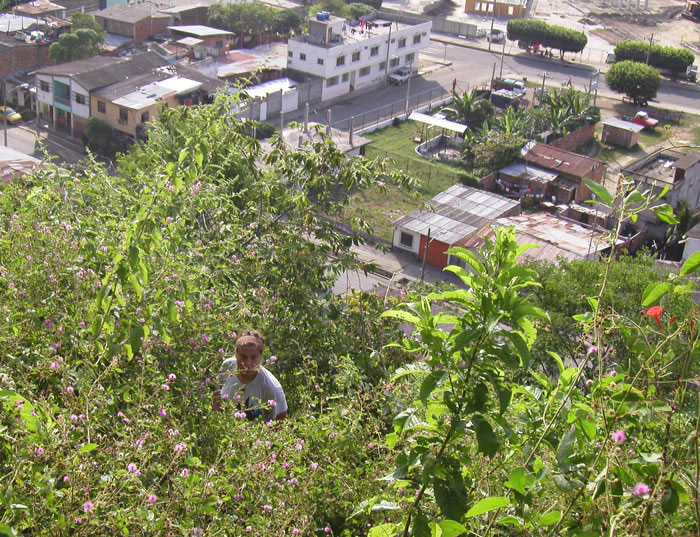
So, at the last minute, I decided to make a site there, to show them that we are willing to get involved, and mean business. In less than a week, the site was designed, prepared and planted, with some community involvement in each phase. Also, over a dozen trees, mostly Pechiches (fruit-producing) were donated directly to individuals.The community will be delegating a family to each tree to take care of planting and watering the trees, which will be planted on the hillside just above the community garden.

While we wait for volunteer numbers to grow, we will stave off watering all of the field and urban community sites for as long as possible, while continuing site maintenance: placing painted sticks at trees and weeding. The greenhouse will get overhauled to plant more seeds, and a new session of Bioregional classes for after-school children kicks off at the end of the month! So stay posted for more happenings and if you want to get involved as a volunteer or supporter, write to planetdrumecuador@yahoo.com .
Pasa bien/take care,
Clay

Reader Interactions